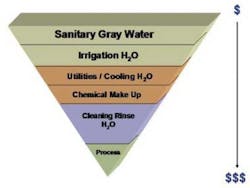Power to the People: Point-Of-Use Technology in Africa
With only half of the rural population in Uganda estimated to have access to drinking water, there remains an urgent need to install immediate solutions to keep pace with a growing population. Jeff Williams puts forward the case for point-of-use technology as a way of empowering local communities.
How we treat, store, conserve, and protect water is becoming one of the central issues in assessing prospects for development the world over. The implications are profound, not only because of the established links between water quality and disease transmission, but also because of the ways in which drinking water safety and availability will likely impact economic growth, especially in the developing world.
Conventional approaches involving large scale, long-term, capital-intensive projects will not be sufficient to fulfill the imminent need to provide billions of people with safe water in a cost-effective manner. Moreover, the UN Millennium Development Goal to reduce by half the number of people without sustainable access to safe water by 2015, simply cannot be reached through reliance on past practices that require such resources.
There is an urgent need to consider other options, particularly in the light of technological advances that have opened up low-cost, highly effective alternatives that can be employed in a sustainable fashion.
Authorities in Uganda have recognised the crucial link between water resource management, public health and long term economic progress (1). With only about half of rural Ugandans having access to safe drinking water (2), waterborne diseases are common, and at times even catastrophic in their impact (3).
As the population increases its rapid growth (4), demands and strains on water supplies and water treatment systems will only get worse. Yet, despite this recognition at the highest national levels, and well-meaning 'Poverty Eradication Action Plans (PEAP)', the gap between these plans and on-the-ground increases in safe drinking water supplies, or piped water provision remains enormous.
The logistic challenges involved in expanding supplies, the huge shortfall in availability of trained technicians, and the precarious dependence of these projects on external donor financing, have made it almost impossible to gain traction in achieving the nation's goals (5). The Uganda Water Partnership has yet to finance a single project. Uganda's fine record of economic progress in recent years is threatened by these developments.
This scenario is certainly not limited to Uganda, and many other nations are equally unlikely to meet the goals set by Africa Water Vision (5) for improving safe water access for their human populations. Among a range of emerging options, stimulated in part by the World Health Organization's (WHO) interests in alternative approaches, is the concept of Point-of-Use (POU) treatment, at household level.
The intent here is to empower consumers to improve water quality themselves by means of simple, user-friendly and economically viable measures applied to raw water sources, without the need for electrical power or pressure. Optimally, these would reduce microbial contamination levels by orders of magnitude without impairing the sensory qualities of high quality potable water—its good taste, odour, colour, clarity and mouth-feel. These characteristics are critically important in ensuring consumer satisfaction with the produced water; if preserved or enhanced, they raise the likelihood of long-term adoption of the proposed intervention.
Here, it turns out, is where the challenge is greatest. Many POU methods can effectively reduce the risk of disease transmission, but at the cost of deterioration of taste and odour, for example. The unfortunate result is that, when left to their own devices, consumers quickly abandon the measures, and revert to using raw untreated water again—primarily due to unpleasant odour, taste and poor clarity.
The development of HaloPure (HP Br), and its recent registration by the USEPA opens up new possibilities in this POU arena. The medium takes the form of tiny spherical beads (Figure 1) that can be incorporated into single-pass, flow-through water treatment devices. This brings about powerful, rapid, broad-spectrum disinfection. Inactivation of bacteria and viruses is effected by surface-bound bromine (Br) atoms, chemically linked to unique sites created on the beads in their manufacture. But by virtue of its 'contact' efficacy, HP Br leaves intact all the desirable traits of drinking water, and raises none of the issues of bad taste and odor associated with other chemical treatment systems.
Combined in a water treatment train with suitable physical filtration and adsorption/absorption components, HaloPure Br can power POU treatment devices to high levels of effectiveness and aims to satisfy householders' needs for good tasting, high quality daily drinking water. Several thousand liters of safe water can be delivered without need for HP Br cartridge replacement.
In their simplest form, water flows by gravity over the sequential components of a treatment train within these HP Br-containing devices. This is usually a combination of filtration media (such as ceramics, carbon blocks, non-woven fibrous materials), then absorptive/adsorptive media (such as activated carbon, exchange resins). So, by the time the water meets the HP beads they face the challenge of dealing with bacterial and viral contamination, and can do their job best.
Since protection of the water post-treatment is a significant issue, HP Br can be configured to deliver a low and imperceptible residual of Br into the flow, ensuring continued biocidal protection on storage (Figure 2). This is a particularly important attribute in dealing with water quality in households at the lower end of the socio-economic spectrum. WHO's position on this point can be summarised as "Safe storage is half the battle".
Many more issues remain to be addressed in putting this kind of technology into the hands of consumers, particularly in developing world environments. Among other things, device design, user friendly operations, distribution channel development, and technical support systems are all critical to implementation. As a first step to getting a handle on user reactions to such a gravity-feed device in an African setting, HaloSource recently placed about 30 units in village households in Tanzania (see image).
This follows tests in India, where the device is already in commercial production. The aim was to take a reading of how housewives reacted to the product, its ease of use, the amount of water it produced for them, and how their families liked the output water, etc. This work was done in collaboration with the Tanzanian National Medical Research Institute. Additional field tests in Indonesia have provided further insights and the company is currently in the process of refining device designs for this kind of market.
There are good reasons for thinking that POU treatment can beneficially impact family health in many developing world environments (6). The company is hopeful that the development of HP Br technology and its incorporation into suitably designed and priced devices may contribute to the rapid expansion of those benefits in the coming years.
References:
1. Uganda Ministry of Water and Environment presentation; http://www.unepdhi.org/MWR2015/Presentation%20-%201WRM%20experiences%20and%20MDGs%20in%20Uganda.pdf
2. "Coverage Estimates:Improved Drinking Water-Uganda."WHO/UNICEF Joint Monitoring Programme for Water Supply and Sanitation, 2006, http://www.wssinfo.org/pdf/country/UGA_wat.pdf
3. "Unusual Cholera Strain Spreads in Uganda."Mail and Guardian, Online, 5 August 2005; http://mg.co.za/article/2005-08-05-unusual-cholera-strain-spreads-in –uganda.
4. "Uganda on Track to Have the World's Highest Population Growth." Worldwatch Institute, 18 September,2006 ;http://www.worldwatch.org/node/4525
5. "Background:Water in Uganda."Anne Perkins, The Guardian Website, 28 March,2008,http://www.guardian.co.uk/katine/2008/mar/28/katinegoalbackground.water.
6. "Household Water Management: refining the dominant paradigm." Thomas Clasen and Sandy Cairncross. Tropical Medicine and International Health. Vol.9, pp187-191, 2004.
Author's note:Jeff Williams, Ph.D., is chief technology officer of HaloSource Incorporated, Bothell, WA, USA. For more information please visit: www.halosource.com.
More Water & WasteWater International Current Issue Articles
More Water & WasteWater International Archives Issue Articles




